
|
||
|
Portland art blog + news + exhibition reviews + galleries + contemporary northwest art
|
||
Erik Geschke's Amalgam 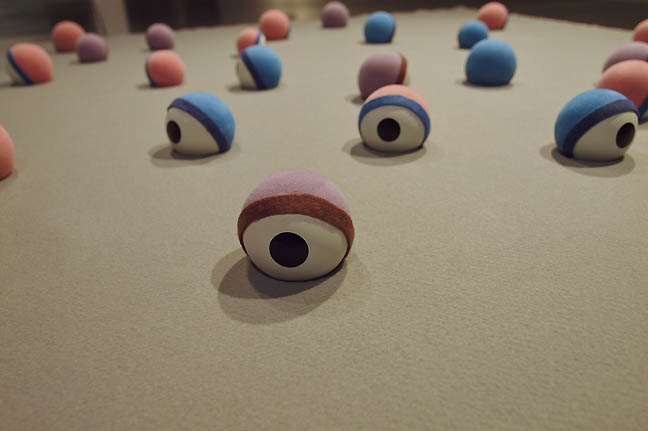 Detail of Erik Geschke's Arena (2015), all photos Jeff Jahn At the end of the year there is always at least one really worthwhile exhibition that sneaks in before the calendar runs out. Currently, there are lots of fine iterative exhibitions that present incremental artistic strides in Portland right now but Erik Geschke's Amalgam at PCC Sylvania is the most satisfying. In no small part this is because Amalgam gives us the real scope of Geschke's recent work, allowing us to explore and absorb his somewhat twisted practice in multifaceted detail. Seek it out. Geschke teaches at PSU but we have had very few opportunities to appraise his work, just a small scale solo exhibition in 2011 at the much missed experimental Manuel Izquierdo Sculpture Gallery at PNCA and a few unsatisfying inclusions that got lost in the melange of large survey exhibitions. In contrast, Amalgam is a concentrated full course survey of recent work and the best one by a local artist this year in Portland. 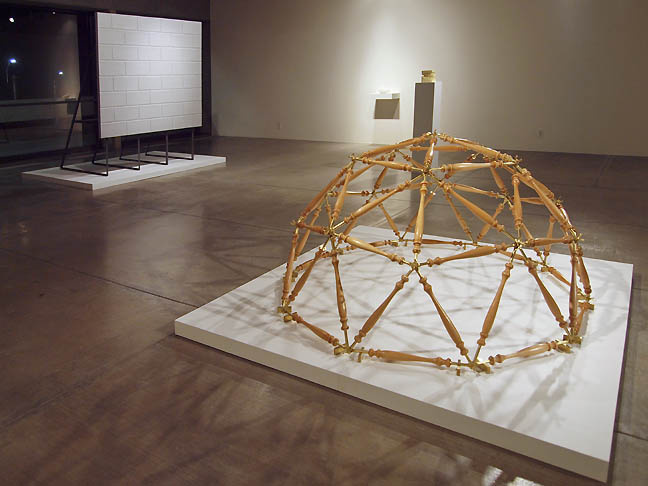 Amalgam install view Thankfully, there is no overeager/arch-earnest curatorial posturing and or multiple venues to spoil this effort. Just the artist being uncompromising in his intents... and yes it well executed because every piece speaks to the other. For example, even weaker pieces like the giant cane titled Prop (how many cane pieces are we going to be subjected to? We get it the USA's most pampered generation, baby boomers are aging as the US empire is in decline) serves to help us appreciate the strengths one of the strongest works in the show called Device. 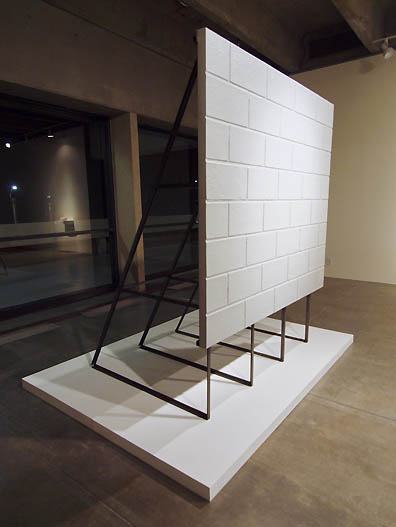 Device (2015) Here in Amalgam, Prop is simply an enlarged version of a cane leaning against a wall, whereas Device is a scale mash up of a cinder block wall mated to an old style billboard... the kind sitting atop many Portland artist studio buildings that are being demolished or converted into lofts. Device succeeds because it channels the very real economic/spatial anxieties or pressures in a now hot city. Geschke essentially gives us the existential whiteness of the developer's whale and it is one of the best pieces regarding Portland's uneasy relationship to rapid urban renewal I've seen. It reminds one that those once undervalued cinder block industrial east side district buildings were the spaces that launched Portland's bid to become an creative capital. A place where young contemporary artists could cut their teeth. Large scale warehouse shows like the Donut shop series (2000-), The Portland Independent Salon* (2001), Alphabet Dress (2001), The Best Coast* (2003), The Modern Zoo (2003), Core Sample (2003) and Beamsplitters (2003), Haze Gallery (2003-2004), Fresh Trouble* (2005) etc. All used huge warehouse spaces and signaled an era of enormous energy and discovery. (*disclosure = shows I curated) 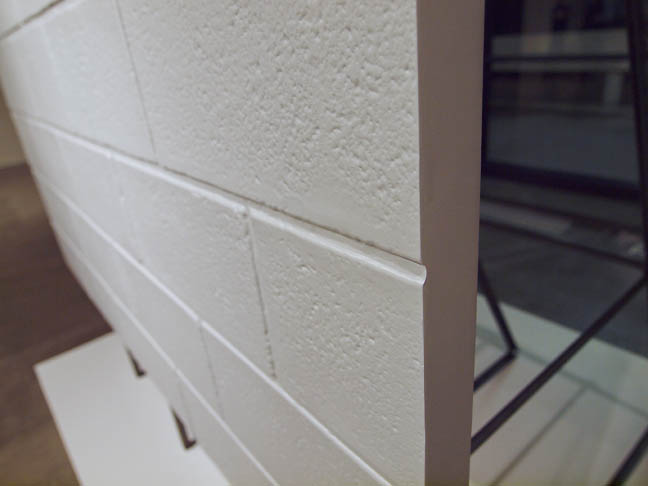 Device, 2015 (detail) Geschke's Device presents a slice of those pregnant spaces washed clean. The section of faux wall has no patina of use... its an unused, an unusable relic of post-industrial spatial potential. Upon close inspection it is obvious it isnt a real cinder block wall at all, just the terrain of one. There is no mortar and like so many Pearl District condo buildings it mimics the texture but is just a light weight skin. It is a fiction manifested.... the palimpsests of real estate. Or perhaps Geschke's work is like a psychological examination in the form of a gallery exhibition? There is no diagnosis here. Portland will weather this real estate storm but it will require institutions and awards to support the gen x-ers and millennials who redefined this place (many actually own homes and are still under pressure). 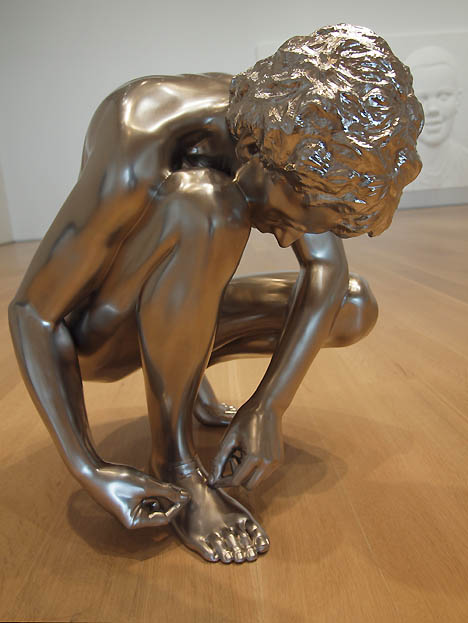
Shoetie, Charles Ray Obviously Geschke deals in simulacra... or as Baudrillard would describe them, "representations of things that have foundation in reality, but never truly existed; simulations are representations of true real-world processes and things that do exist." Currently artists like Charles Ray, Jeff Koons, Maurizio Cattelan, Ai Wei Wei, Duane Hanson (d. 1996) and Rachel Whiteread would be the leading contemporaries in the field and locally Heidi Schwegeler works in simulacra too, but found objects as well and MK Guth once cast an entire kitchen in resin too. Pop artist Claes Oldenburg also should be noted as perhaps a godfather of the technique with his giant mundane object sculptures. Shifts of scale and transposition into different material are common strategies and as a strategy is related to both surrealism and Dada. If pressed I would place Geschke closest to Charles Ray and Whiteread in that he downplays the mute content his simulacra rather than amp it's theatrics up like Cattelan or Koons does. Schwegler also follows Ray's lead but with a little more of Cattelan's cheeky approach. Whereas, the difference between Geschke and Ray is that Geschke's work seems impersonal, in the same way Whiteread makes sculpture of of the spaces beneath staircases. In contrast, Ray's work is often ultra personal like Shoetie where the sculpture is the artist himself translated imperfectly by laser scanning. This lack of strong personal attachment gives Geschke's work a stronger dadaist and less sociological quality, but instead of a Duchampian ready made (which isnt a simulacra by definition) they are crafted. Geschke's very polished work exudes a high level of craft but not to the point of being so "deluxe" that the finish aspect becomes the message like in a Koons. Instead, the works retain the mute dadaist, purposefully apolitical nature. Like the dadaists, Geschke's work doesnt seem to suggest any political affiliation and in such polarized times that intentional lack of polemics is noticeable. At the same time, Geschke's high levels of craft lack the humble brag you see too often... such as drawing attention to emphasized handicraft or cheap relational aesthetics materials. Instead of humble objects, they seem more like prototypes, or a collector's wunderkammer... they are fantastical in their almost negative potential to prostrate themselves for the viewer. They have poise and present us with an experiential stalemate. 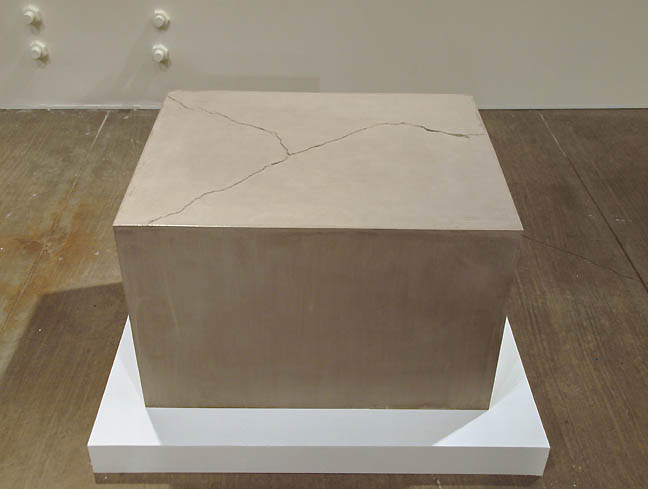 Cracks in the Stable (2015) For example, Cracks in the Stable, which originated from Geschke's Djerassi residence earlier this year seems to imply change via its subject matter, while the casting process itself implies stasis. Sure, it resembles the US political system but that's just me as a viewer imprinting a projection upon the work, someone else might just interpret as Geschke being aesthetically perverse during a residency in a sublime natural environment? 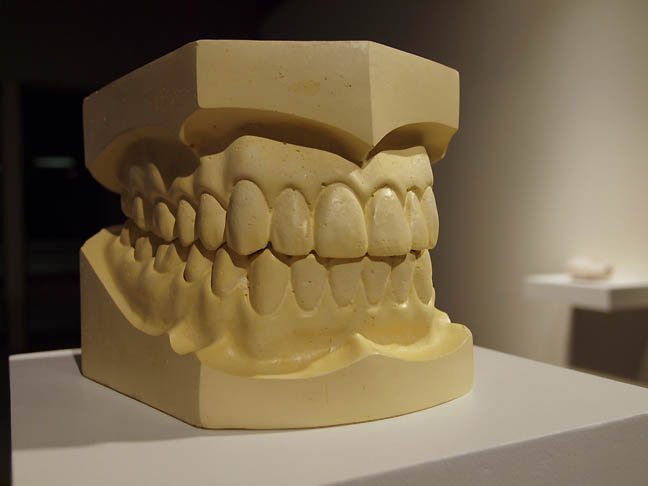 Vociferous Architecture (2015) Other pieces like Vociferous Architecture, comprised of an oversized casting of a dental cast could be a comment on our healthcare system now in flux. Geschke's cast is bigger than normal, but still mute. Is it working? No idea! ...welcome to the present. 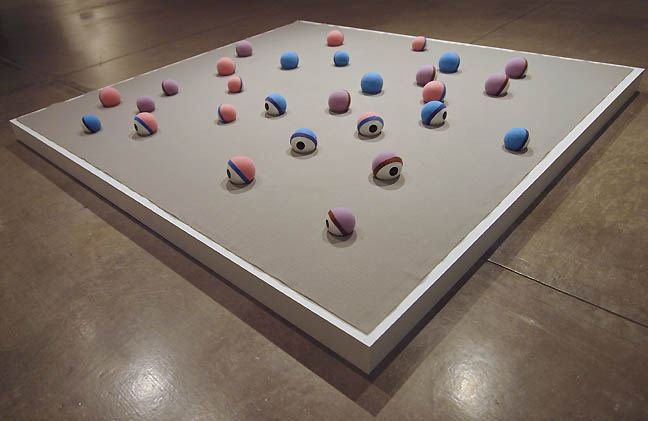 Arena (2015) My favorite work in the show though is Arena. Comprised of a field of Muppet style baby blue and pink lidded felted eyeballs it is hard to tell if this is a depot of left over parts waiting for use or some grim puppet serial killer's trophy room? It is funny in a laugh from fear kinda way and for me the way they all seem to be staring ankle height at nothing in particular feels like our internet social media surveillance era. The Arena of course is whatever psyche the viewer brings to it. Is it our childhood or the way puppets are often so creepy as simulacra themselves? Do we want the attention? Are likes, followers or retweets really a kind of currency in an era of narcissism? Or perhaps this could be read as a parent being subjected to the horrors of children's programming that Jim Henson has spawned? 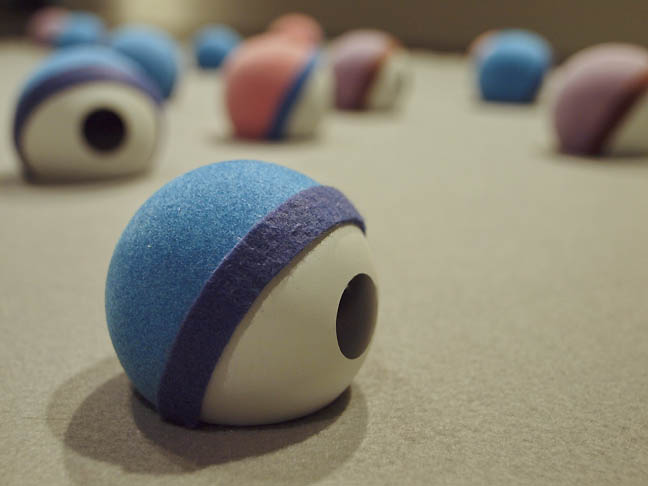 Arena, 2015 (detail) Then there is the natural sweetness in Arena, something only felt can convey...? What I love is the way this is the only colorful and soft piece in the entire show. Other somewhat gimmicky works like Surrogate, yet another cast head... or Untitled (Invidious consumption), a jungle gym dome made of hemlock wood furniture parts look better because it is in the room with Arena. Without Arena those works suffer from a lack of an audience of supposedly childhood innocence, dipped in a potential for sarcasm. 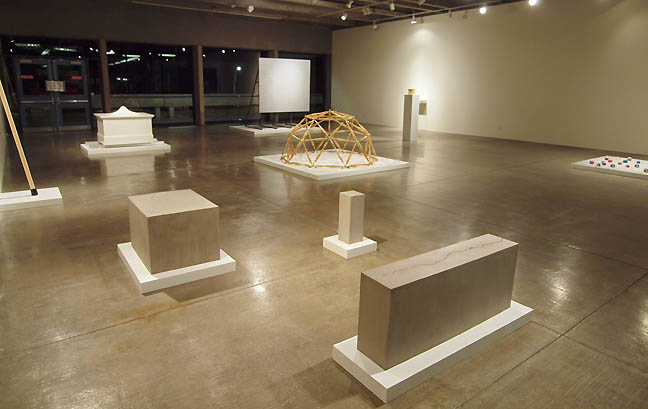
Amalgam install view I suppose that Arena is just a great Gen X tableaux... a mute existential commentary on the mild form of horror my generation grew up witnessing during the cold war and global corporate expansion. The Sesame Street and Fraggle Rock utopias we were fed on TV never panned out... and as a fellow gen x-er we knew they wouldnt. Yet Jim Henson's empire trudges on. Perhaps, Geschke's Arena says we are not entertained. Were we ever? Maybe this work isnt collaborative enough for millennials but I gotta say Im really proud that Geschke and my generation produced this show.... it bites differently than the self absorption of Charles Ray does. Frankly, I dont like these generational terms much but Portland has been favored and rebuilt by milennials and gen x-ers (often working together) and I like the way Amalgam's deadpan 1000 yard stare at our present feels like we have been here before. The world and Portland have their problems but there are smart, capable talented people like Geschke in Portland who make it an engaging place worth fighting for. Overall, there doesnt seem to be any conscience to the mute works of Amalgam but its that lack of clear worldview that is exciting... you visit this show and you can hear yourself think because as you step back it resembles a visit to a cemetery. Let's not forget that a lot of the romanticism of the Nineteenth Century flowed from such quiet, dead places as a commentary on the industrial world. Visit Amalgam and pay your respects this holiday season if you want a sober, introspective and less hectic experience. Amalgam | November 19 - December 19 Closing Reception: December 19 5-8PM PCC Sylvania (North View Gallery) 12000 SW 49th Posted by Jeff Jahn on December 11, 2015 at 15:51 | Comments (0) Comments Post a comment Thanks for signing in, . Now you can comment. (sign out)
(If you haven't left a comment here before, you may need to be approved by
the site owner before your comment will appear. Until then, it won't appear
on the entry. Thanks for waiting.)
|
| s p o n s o r s |
 |
 |
 |
 |
 |
 |
 |
 |
 |
 |
 |
 |
 |
 |
 |
 |

|
Site Design: Jennifer Armbrust | • | Site Development: Philippe Blanc & Katherine Bovee | |

